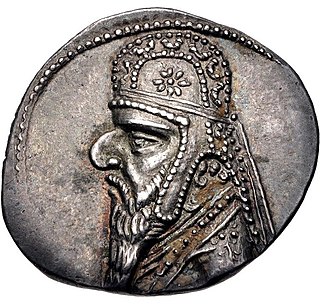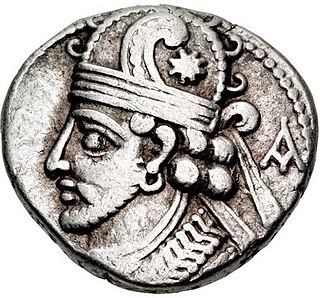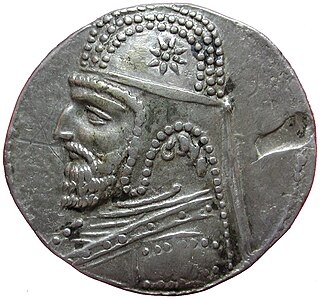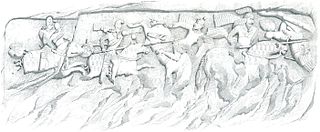
Mithridates II was king of the Parthian Empire from 124 to 91 BC. Considered one of the greatest of his dynasty to ever rule, he was known as Mithridates the Great in antiquity.

Arsaces I was the first king of Parthia, as well as the founder and eponym of the Arsacid dynasty of Parthia, ruling from 247 BC to 217 BC. The leader of the Parni, one of the three tribes of the Dahae confederacy, Arsaces founded his dynasty in the mid-3rd century BC when he conquered the satrapy of Parthia from Andragoras, who had rebelled against the Seleucid Empire. He spent the rest of his reign consolidating his rule in the region, and successfully stopped the Seleucid efforts to reconquer Parthia. Due to Arsaces' achievements, he became a popular figure amongst the Arsacid monarchs, who used his name as a royal honorific. By the time of his death, Arsaces had laid the foundations of a strong state, which would eventually transform into an empire under his great-grand nephew, Mithridates I, who assumed the ancient Near Eastern royal title of King of Kings. Arsaces was succeeded by his son Arsaces II.

Ardashir I or Ardeshir I, also known as Ardashir the Unifier, was the founder of the Sasanian Empire. He was also Ardashir V of the Kings of Persis, until he founded the new empire. After defeating the last Parthian shahanshah Artabanus IV on the Hormozdgan plain in 224, he overthrew the Parthian dynasty and established the Sasanian dynasty. Afterwards, Ardashir called himself "shahanshah" and began conquering the land that he called Iran.

King of Kings was a ruling title employed primarily by monarchs based in the Middle East. Though most commonly associated with Iran, especially the Achaemenid and Sasanian Empires, the title was originally introduced during the Middle Assyrian Empire by king Tukulti-Ninurta I and was subsequently used in a number of different kingdoms and empires, including the aforementioned Persia, various Hellenic kingdoms, Armenia, Georgia, and Ethiopia.

Mithridates IV was a Parthian king from to 57 to 54 BC. He was the son and successor of Phraates III. Mithridates IV's reign was marked by a dynastic struggle with his younger brother, Orodes II, who eventually emerged victorious and had Mithridates IV executed, thus succeeding him.

Sinatruces was king of the Parthian Empire from c. 75 BC to c. 69 BC. He was presumably a son of the Parthian ruler Mithridates I. Sinatruces was succeeded by his son Phraates III.

Artabanus II, incorrectly known in older scholarship as Artabanus III, was King of Kings of the Parthian Empire from 12 to 38/41, with a one-year interruption. He was the nephew and successor of Vonones I. His father was a Dahae prince, whilst his mother was a daughter of the Parthian King of Kings Phraates IV

Vonones I was an Arsacid prince, who ruled as King of Kings of Parthian Empire from 8 to 12, and then subsequently as king of Armenia from 12 to 18. He was the eldest son of Phraates IV and was sent to Rome as a hostage in 10/9 BC in order to prevent conflict over the succession of Phraates IV's youngest son, Phraataces.

Vardanes I was a king of the Parthian Empire from 40 to 46 AD. He was the heir apparent of his father Artabanus II, but had to continually fight against his brother Gotarzes II, a rival claimant to the throne. Vardanes' short reign ended when he was assassinated while hunting at the instigation of a party of Parthian nobles.

Gotarzes II was king of the Parthian Empire from 40 to 51. He was an adopted son of Artabanus II. When his father died in 40, his brother Vardanes I was to succeed to the throne. However, the throne was seized by Gotarzes II. Gotarzes II eventually was able to gain control of most of Parthia forcing Vardanes to flee to Bactria. With the death of Vardanes in c. 46, Gotarzes II ruled the Parthian Empire until his death. Gotarzes II was succeeded by his uncle Vonones II.

Vonones II was a Parthian prince who ruled as king of Media Atropatene and briefly as king of the Parthian Empire.

Pacorus II was the King of Kings of the Parthian Empire from 78 to 110. He was the son and successor of Vologases I.

Orodes I, was king of the Parthian Empire from 80 to 75 BC. He was the son and heir of Gotarzes I. His reign is relatively obscure. His throne may have been usurped in 87–80 BC by his supposed uncle Mithridates III, however, this has found little support in scholarship. Of his military activities, it is known that Orodes I re-established Parthian rule in Elymais in 78 BC, which had been independent since 81/80 BC. Orodes I later lost the throne to the aged Parthian prince Sinatruces, who belonged to a different branch of the royal Arsacid family.
Sāssān, considered the eponymous ancestor of the Sasanian Dynasty in Persia, was "a great warrior and hunter" and a Zoroastrian high priest in Pars. He lived sometime near the fall of the Arsacid (Parthian) Empire in the early 3rd century CE.

Pabag, was an Iranian prince who ruled Istakhr, the capital of Pars, from 205 or 206 until his death sometime between 207–210. He was the father or stepfather of Ardashir I, the founder of the Sasanian Empire. He was succeeded by his eldest son Shapur.

The Battle of Hormozdgan was the climactic battle between the Arsacid and the Sasanian dynasties that took place on April 28, 224. The Sasanian victory broke the power of the Parthian dynasty, effectively ending almost five centuries of Parthian rule in Iran, and marking the official start of the Sasanian era.

Sanabares was an Indo-Parthian king. He was the last Indo-Parthian king to rule in both Sakastan and south Arachosia, as the Kushans under Wima Kadphises made inroads into Indo-Parthian territory.

Mithridates III was king of the Parthian Empire from 87 to 80 BC. His existence is disputed in scholarship.

Farn-Sasan was the last king of the Indo-Parthian Kingdom, ruling the region of Sakastan approximately from 210 to 226. Literary sources makes no mention of him, and he is only known through the coins he issued. He was defeated in 226 by the Sasanian ruler Ardashir I, which marked the end of Indo-Parthian rule.

Dara II or Darab II was the last king of the mythological Kayanian dynasty, ruling between 14 and 16 years. He is generally identified with Darius III, the last king of the Achaemenid Empire. In Middle Persian literature and Islamic chronicles, he is generally known as "Dara", while he is known as "Darab" in the New Persian proses Darab-nama and Iskandar-nama. He was the son and successor of Dara I.




















